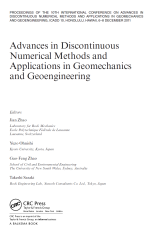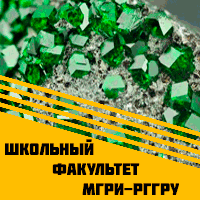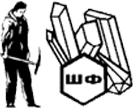Добрый день, Коллеги. Важное сообщение, просьба принять участие. Музей Ферсмана ищет помощь для реставрационных работ в помещении. Подробности по ссылке
Advances in discontinuous numerical methods and applications in geomechanics and geoengineering / Достижения в области дискретных численных методов и их применения в геомеханике и геоинженерии
The proceedings of ICADD-10 is a collection of 56 technical papers, including 8 keynotes, accepted by the conference. ICADD-10 is the 10th event of the series since 1995. The conference series have been organised every 2–3 years focusing initially on the discontinuous deformation analysis method and gradually covering the discontinuous numerical methods and coupling techniques with other numerical approaches, for geomechanics and geoengineering. Geomechanics can be viewed often as discontinuum mechanics, as rocks and soils can behave as discontinuous materials, physically and mechanically. Deformation and failure of rocks and soils often involve grain separation and interface movement. The discontinuous nature is inevitable in rock masses and granular soils. It was therefore, not surprised that the starting of the main discontinuous numerical methods, the distinct element method by Dr Peter Cundall in 1972, and discontinuous deformation analysis by Dr Gen-Hua Shi in 1985, all associated with rock mechanics.
Discontinuous numerical methods have now been widely applied in geoengineering related to civil, mining, hydropower and petroleum engineering. There are many good examples of using UDEC/3DEC and DDA in design and forensic of geoengineering projects, in dams, slopes, tunnels, caverns and mines. The discontinuous numerical methods provide good tools to capture the true physical and mechanical behaviours of the geomaterials, and provide the scientific insights enabling for better engineering design, by numerical modelling. Discontinuous numerical methods are indeed very much engineering tools of the present, and certainly more in the future.
As ICADD-10 marks the 10th event of the ICADD series, the conference focuses on review and progress, with the conference title “back to the Future”. The papers included in this proceedings cover a wide scope of discontinuous numerical methods from algorithms and mechanics, to modelling techniques and applications, including the key block theory, the discontinuous deformation analysis, the numerical manifold method, the distinct/ discrete element method, coupled discontinuum and continuum methods, multi-scale and multi-physics in modelling, applications and case studies of engineering projects. ICADD-10 is jointly organised by the rock mechanics groups at the Ecole Polytechnique Fйdйrale de Lausanne (EPFL) in Switzerland and the University of Kyoto in Japan, and supported by the American Rock Mechanics Association (ARMA) and the Society for Rock Mechanics and Engineering Geology of Singapore (SRMEG). The conference organising committee is co-chaired by Jian Zhao and Yuzo Ohnishi, and teamed with Yuyong Jiao, uowei Ma, Takeshi Sasaki, Liang Sun, Gao-Feng Zhao, and Yingxin Zhou. The publication of this proceedings is supported by Leon Bijnsdorp and Richard Gundel of CRC Press. <...>
Rock block stability analysis of slopes and underground power houses G.H. Shi
Recent developments and future trends in distinct element methods— UDEC/3DEC and PFC codes J.V. Lemos
Application of DDA and NMM to practical problems in recent new insight Y. Ohnishi, T. Koyama, T. Sasaki, I. Hagiwara, S. Miki & T. Shimauchi
Complete and high order polynomial displacement approximation and its application to elastic mechanics analysis based on DDA A.Q. Wu, Y. Zhang & S.Z. Lin
Discontinuum based micromechanics modelling methods G.F. Zhao & J. Zhao (EPFL)
Immersed boundary based fluid coupling in mechanics of discontinua A. Munjiza, J.J.R. Williams, E.J. Avital, J. Cin & D. Xu
Toward a realistic rock mass numerical model G.W. Ma & G.Y. Fu
DDARF-A simple solution for simulating rock fragmentation Y.Y. Jiao & X.L. Zhang
Discontinuous deformation analysis method and applications New contact resolution algorithm using two-stage contact definition and rounding scheme in 3D DDA T.Y. Ahn & J.J. Song
Coupling fluid flow with discontinuous deformation analysis Y.X. Ben, J. Xue, Q.H. Miao & Y. Wang
Numerical simulation of landslide turning into debris flows using discontinuous deformation analysis method B. Hu, A.Q. Wu, B.W. Gong & B. Lu
DDA simulations for slope failure/collapse experiment caused by torrential rainfall T. Koyama, K. Irie, K. Nagano, S. Nishiyama, N. Sakai & Y. Ohnishi
Using natural-neighbor-interpolation-based DDA method for elasto-plastic analysis of discrete block system Y.Z. Ma & H. Zheng
A numerical study of the significance of joint roughness in discontinuum modelling A. Mortazavi & A. Bonakdar
History of road construction with discontinuous analysis in Japan T. Nakai, K. Hatakeyama & Y. Ohnishi
Nonreflecting boundaries for the discontinuous deformation analysis Y.J. Ning & Z.Y. Zhao
Studies on rock fall problems by three dimensional discontinuous deformation analysis T. Sasaki, I. Hagiwara, S. Miki, Y. Ohnishi & T. Koyama
Anchorage effect on fractured rock and cavern stability analysis using DDA method S. Yu, W. Wang & W. Zhu
Masonry retaining wall under static load using discontinuous deformation analysis J.Q. Tian, S. Nishiyama, T. Koyama & Y. Ohnishi
Development of graphic user interface for Discontinues Deformation Analysis (DDA) G.F. Zhao, N. Khalili, X.B. Zhao & X.B. Tu
On the implementation of augmented lagrangian method in the 2D discontinuous deformation analysis Z.Y. Zhao, H.R. Bao & Q. Tian
The method of slope modelling for rockfall analysis using 3D DDA L. Zheng, G. Chen, K. Zen & K. Kasama
Key block theory, block cutting and applications Generation of three-dimensional rock mass geometrical model G.Y. Fu & G.W. Ma
An efficient block detection algorithm in 3D-DDA A. Jafari & M. Khishvand
Block identification algorithm for complex free planes J.Y. Li, J. Xue, J. Xiao & Y. Wang
Stability analysis of determined blocks in the underground powerhouse of guandi hydropower station B. Lu, X.L. Ding, Z.H. Dong & A.Q. Wu
Modeling method for complex key block based on Nef polyhedra J. Xue, Q.H. Miao, Y.X. Ben, J.Y. Li & Y. Wang
Three-dimensional block cutting and its some applications to rock engineering Q.H. Zhang & A.Q. Wu
Numerical manifold method and further developments Application of manifold method to punch loading tests for polymer bonded explosives K. Dai, P. Chen & H. Huai
Study for reinforcement planning of masonry structure with cracks at Bayon main tower, Angkor M. Hayashi, S. Yamada, M. Araya, T. Koyama, M. Fukuda & Y. Iwasaki
Accelerating contact detection using spatial hashing for Numerical Manifold Method Q.H. Miao, J. Xue, Y.X. Ben & L. Li
Research on solving geometric nonlinear problems with fixed triangular meshes H. Su, Y. Gong & X. Xie
An introduction of Particle Manifold Method (PMM) L. Sun, G.F. Zhao & J. Zhao (EPFL)
Simulation of seepage in porous medium by Numerical Manifold Method Y. Wang & J.K. Gong
Research on 3 dimension manifold method and its application Y. Wu, G. Chen, Z. Jiang, Q. Li, W. Wei, X. Liu & J. Zhao (CEA)
Distinct element method and applications A numerical study of goaf stability under a desert expressway S.G. Chen, C. Hu & L. Xiong
A study on hole-cutting in deep tunneling S.G. Chen, L. Chen, C. Hu & X.R. Tan
A numerical study on shear characteristics of jointed rock under thermo—mechanical coupled condition T. Kim, C-S. Lee & S. Jeon
PFC numerical simulation of particle breakage of the clay core rock-fill dam F.H. Liu, J. Liu & X.J. Kong
A study on the stability of a big-section tunnel in karst area H. Ma, S.G. Chen, C. Hu & X.R. Tan
Modelling dynamic crack propagation by distinct lattice spring model H.S. Ma, H.G. Ji, L.J. Yin & G.F. Zhao
A numerical analysis of the effect of rock bridges on wave propagation A. Mortazavi & M. Sharafisafa
Continuum and discontinuum analysis of large shallow rock caverns V. Nasri, S. Rashidi, N. Allahverdi & M. Sepehrmanesh
Simulation of progressive failure in slope using distinct element method with the gravity increased procedure T. Nishimura, H. Hiramatsu & S. Kayano
Stability analysis and reinforcement evaluation of the left bank slope in Jingping I hydropower station G. Rong, Q-H. Jiang, C-B. Zhou, J. Peng, X-J. Wang & T. Chen
Investigate water flowing in fractured strata over a gob zone Z. Yang, C. Huang, S. Liu, B. Wang, S. Wang & L. Wang
Reliability assessment of ultimate and serviceability limit states of underground rock caverns W.G. Zhang, A.T.C. Goh & J.Y.K. Wong
UDEC application in rock support optimization for Pianqiao diversion tunnel Y.B. Zhao, S.G. Chen, C. Hu & X.F. Deng
A three-dimensional stochastic granule model with real shapes and numerical simulation of rockfill behavior W. Zhou, X.L. Chang & C-B. Zhou
Discontinuous modelling of finite element and other methods Elastic-plasticity deformation analysis for rock slope with anti-dip angle contact interface X.D. Li & C. Su
An analytical study about dynamic failure mechanism of anchor bolts embedded in concrete S. Munemoto & Y. Sonoda
Computational coupling methods of dynamic problems with different discrete idealizations K. Sato, S. Maeda, T. Kawahara, Y. Tanaka & H. Takeda
Stability study of surrounding rock with parallel weak interlayer C. Su, Y.S. Jiang & X.D. Li
Moisture and heat transfer characteristics of the pavement with water retention base course E. Tomotsugu, S. Yasunori, K. Morito, C. Su, Y.S. Jiang & X.D. Li
Contact analysis and foundation reinforcement measures of ship lock on soft foundation C. Xu, C. Su & F.
Sheng On accuracy of solution for explicit and implicit dynamic formulation with hybrid-type penalty method T. Yagi, N. Takeuchi & K. Yamamura




